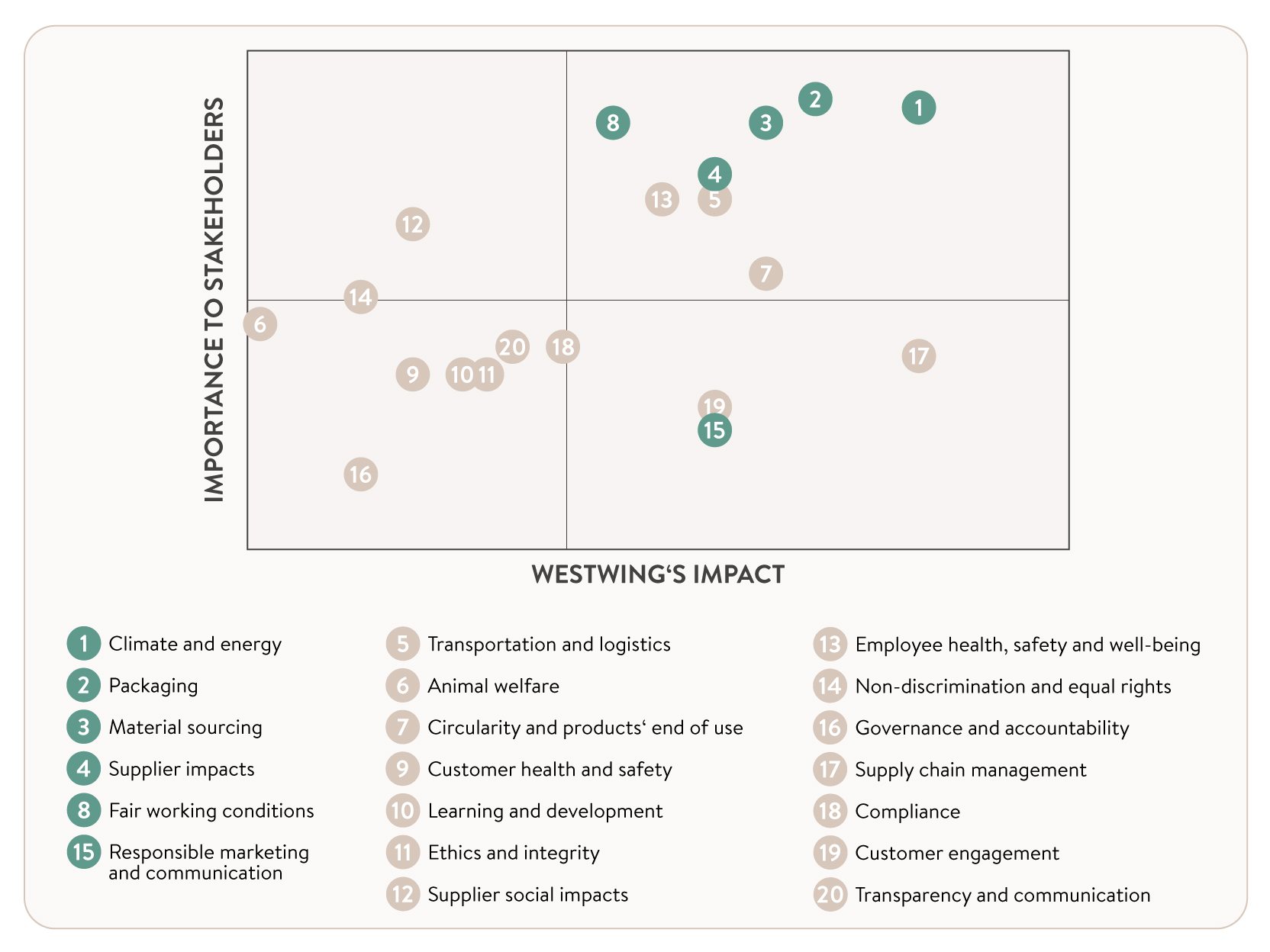Sustainability materiality assessment
Determining what matters most.
We are aiming to give sustainability pride of place in our company by addressing some of the most pressing environmental, social, and governance (ESG) issues. We know we cannot do this all at once and that we need to set priorities. This is why we conducted a materiality assessment in 2021. We sought input from our employees, our Executive team, our customers, and other external stakeholders. We also reviewed our existing policies and practices, and analyzed key policy trends, formal investor requirements, and our competitors’ activities and performance. The topics that we identified as most important to us and our stakeholders formed the basis for our ambitious 2030 Sustainability Strategy.
Our approach
We aligned our approach with the Global Reporting Initiative (GRI) standards by evaluating a long list of ESG topics from two perspectives:
a) their importance to our internal and external stakeholders, and
b) Westwing’s impact on those topics. Our approach consisted of four main steps:
Identification
The first thing we did to identify the range of ESG topics that are potentially relevant to Westwing was to review our existing policies and practices, customer feedback, and external sustainability standards (e.g., the GRI standards and the standards issued by the Sustainability Accounting Standards Board). We also analyzed policy trends, ESG investment requirements, and the approaches adopted by our peers and other companies. Finally, we surveyed our Executive team and conducted interviews throughout the company.
Prioritization
Next, we conducted an online survey to prioritize the ESG topics identified during the first step.. Customers, suppliers, employees, and other external stakeholders (NGOs, academic institutions, and industry associations) were requested to evaluate the long list of ESG topics for their importance to them. In addition, our suppliers and other external stakeholders were asked to evaluate Westwing’s impact on those topics. More than 1,100 responses were received, enabling us to prepare a preliminary materiality matrix.
Validation
After this, we held an Executive team workshop to evaluate and critically assess the survey results in the context of our business strategy and requirements, after which we finalized the materiality matrix in line with this.
Review
We plan to regularly review and update our materiality matrix to reflect the views of key internal and external stakeholders, and developments in voluntary and compulsory non-financial reporting. This will also allow us to incorporate changes in business priorities and emerging ESG topics. In the meantime, we will continue to focus on delivering on our Sustainability Strategy and on implementing sustainability-centered initiatives and activities.

Results - our material topics
Our materiality assessment identified six topics where our operations have a material impact and that are also relevant to our stakeholders and our business. These topics have been taken into account in our 2030 Sustainability Strategy and for reporting purposes.
Responsible marketing and communication
Respecting our customers and communicating honestly is crucial to building trust and loyalty. We strive to provide clear, credible information on our products, and to inspire our customers to live more sustainably.
Fair working conditions
Our team is our biggest asset, and we want to provide them with the best working conditions possible, from supporting their mental and physical well-being down to ensuring their health and safety. We also show the same interest and concern to the people involved in our supply chain.
Supplier impacts
Our suppliers and brand partners are very important to us, which is why we cooperate closely with them to address their social and environmental impacts as part of our commitment to sustainability.
Climate and energy
Manufacturing and distributing our products contributes to greenhouse gas emissions. We have therefore made it our priority to avoid and reduce emissions, and are leveraging our operations expertise to respond to climate change.
Packaging
It is important to us and our customers that we use the most environmentally friendly materials possible, and that we reduce the resources involved in making our packaging.
Materials sourcing
We want to create inspiring products using high-quality, sustainable materials.
 English
English Deutsch
Deutsch